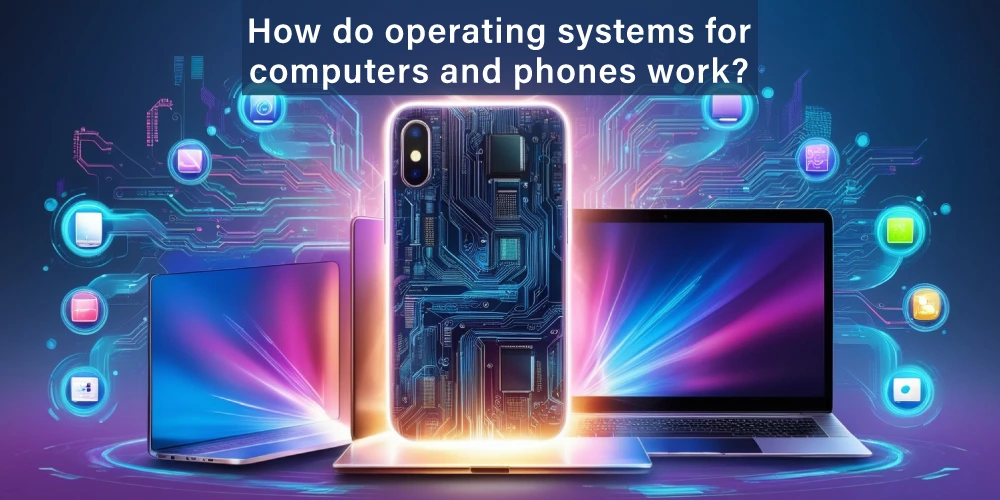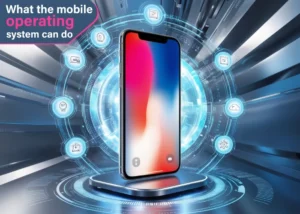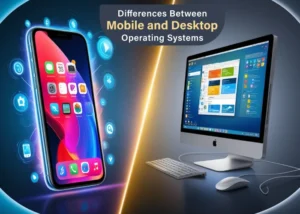There are two main types of operating systems: desktop and Mobile. Desktop operating systems power computers and mobile devices, while mobile operating systems control how they work. A desktop operating system (OS) like Windows, macOS, or Linux is made to run on personal computers. It has many features that make it useful for many jobs, from work to play to making multimedia. A Mobile OS, like Android or iOS, on the other hand, is designed to work best on smartphones and tablets. It makes touch-based interactions, movement, and connecting to cellular and wireless networks easy. Both types of OS take care of hardware and software resources, but each one is designed to meet the specific needs of its platform. It does this by balancing power, usefulness, & user experience to meet the needs of users. Let’s talk about how operating systems work on phones and computers.
What does a Mobile Operating System mean?
Apps can run on mobile devices with the help of a mobile operating system (OS). In some ways, it’s like desktop OS, but it’s easier to use and takes up less space. Windows Mobile, Symbian OS, RIM’s Blackberry, Android, iPhone OS, and Maemo are some of the smartphone operating systems. Linux OS comes in many forms, such as WebOS, Android, and Maemo. Both BSD and NeXTSTEP are UNIX-based and are used to make the iPhone OS. Mobile operating systems mix features from computers and handheld gadgets. A cellphone modem and SIM card tray are often built in for phone and Internet services. When you buy a mobile, it comes with an operating system that is designed to work with that device. Like:
-
Managing the Process
The OS plans the order of tasks that run on the CPU (Central Processing Unit). It also lets you add, delete, and sync tasks.
-
How to Manage Memory
The operating system does more than end a process. It also gives and takes away memory from the process. It also keeps track of the different parts of memory that each method uses.
-
Managing files and the system
Additionally, the operating system adds and removes folders and files from the system. It also comes with backup help in case something goes wrong.
Taking care of devices
The operating system also manages and controls the Input/Output devices attached to the computer.
- The user interface
- The operating system also serves as an interface between the user and the hardware, giving the user a platform to interact with the computer simply and without being aware of any hidden intricacies.
What the mobile operating system can do
There are various features of a Mobile Operating System. Such as some features of the Mobile Operating System are as follows:
- It’s straightforward to understand and utilize it. The graphics of the mobile operating system are beautiful, and its features are compelling and easy to use.
- An OS focuses on controlling the data and network usage. It also keeps the limit, time requirements, and other requirements in focus.
- It provides better apps to use for new users.
What is a Desktop Operating System?
A desktop operating system is a type of operating system that is typically used in large-screen devices with mouse and keyboard inputs, such as personal computers and desktops. The desktop operating system controls the machine’s memory, hardware resources, and attached peripherals. Computers and laptops with big screens often use desktop operating systems. Multitasking is possible with these operating systems, which also boosts system productivity. Other tasks carried out by desktop operating systems include managing files, scheduling processes, and managing memory.
Some of the most common desktop operating systems include:
-
Windows
Windows is the most popular operating system, and almost all personal computers use computer brands.
-
macOS
MacOS is the exclusive operating system developed by Apple that is used on large-screen devices like laptops and desktops.
-
Ubuntu
Ubuntu is one of the popular Linux distributions. It offers free and open-source alternatives to Windows and macOS.
-
Chrome OS
Chrome OS is developed and used by Google. It is a lightweight operating system that is used primarily in Google’s Chromebook series of laptops.
-
Fedora
Like Ubuntu, Fedora is another widespread Linux distribution. It is a reliable and feature-rich open-source platform.
Differences Between Mobile and Desktop Operating Systems
Here, you will discover the primary differences between Mobile and desktop Operating systems. They include:
- Mobile operating systems allow mobile applications to operate smoothly on mobile devices, while desktop OS provides the environment in which a user handles personal computers.
- Mobile operating systems utilize flash drives for data storage, while desktop operating systems rely on hard drives and flash drives for this task. Optimizing mobile OS requires only limited RAM, while its desktop counterpart requires much more significant amounts.
- Mobile OSs manage wireless and cellular connections and device access, while desktop OSs manage software and hardware resources on a system level.
- Mobile OS runs on touch screen or touchpad devices, while desktop OS operates through many input devices like a mouse, keyboard, and more.
- Mobile OS takes less time to boot compared with its counterpart; on the other hand, desktop OS takes much longer.
- Mobile OSes have been optimized to work under lower power requirements, with features to reduce energy loss. Desktop operating systems could be more readily optimized to minimize this loss.
- These mobile operating systems (OSs) include Apple iOS, Blackberry OS, iPhone, Google Android, Palm OS, Windows Mobile Harmony OS, and Web OS as examples of Mobile OSes, while desktop operating systems include Windows 10, MacOS, Vista & 8.
F&Q:
What is the main goal of mobile operating systems?
Mobile operating systems are used on portable devices like smartphones and tablets. The primary purpose of mobile OS is to optimize energy usage to increase the device’s battery life.
What is the main difference between Mobile and desktop operating systems?
Mobile Operating systems are designed to provide functionality like touchscreen and long battery life in portable devices like smartphones. On the other hand, desktop operating systems are built for larger machines with mouse and keyboard inputs.
What is the role of graphical User Interface in the operating system?
The Graphic user interface provides a visual way for users to interact with the OS and applications. GUI includes elements like icons, windows, buttons, menus, etc.
Conclusion
In this article, we discuss how desktop and mobile operating systems are operating.- we discussed the Difference between Mobile and Desktop Operating systems. We discussed mobile operating systems and desktop operating systems in detail. We also discussed some critical differences between Mobile and desktop operating systems. In the end, we concluded by discussing some frequently asked question



